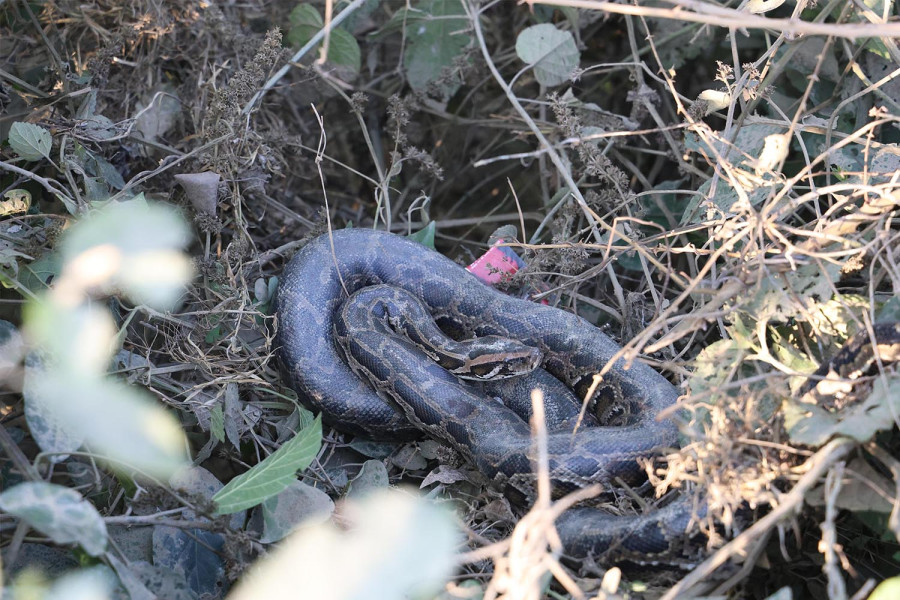National
Rare sighting of four adult pythons at one location in Rupandehi delights conservationists
The pythons spotted on Tuesday have been identified as Burmese pythons. Conservationists say the reptiles might have gathered for mating.
Manoj Paudel & Dipendra Baduwal
As many as four pythons, known as Ajingar in Nepali, were sighted in Lumbini Sanskritik Municipality, Rupandehi, on Tuesday. The constricting snakes were spotted near a bridge over the Telar stream along Mahilwar-Padariya road section of the municipality.
Conservationists are happy upon seeing multiple pythons at the same place. “This [the cold winter months of December and January] is the mating season of pythons,” explained Karan Bahadur Shah, a renowned researcher of amphibians and reptiles in Nepal. “The reptiles might have gathered there for mating. The gathering of so many adult pythons in the same place is good news for the conservation sector.”
According to conservationists, two python species—Indian rock python and Burmese python—are found in Nepal. The pythons which were spotted in the Telar stream belong to Burmese python species (python bivittatus).

One of the pythons was hanging in a tree north from the bridge while another coiled on the grass nearby. Two other pythons were sighted in holes just below the bridge. All four pythons were nearly three metres in length and weighed around 20-22 kilogrammes.
The pythons were spotted near the southern gate of Lumbini, the birthplace of Gautam Buddha. Many people gathered at the site to take photos and videos of the pythons, mainly of the one hanging in the tree. The pythons stayed at the same place throughout the day and hid in the holes and undergrowth in the evening.
According to Raj Adhikari, a wildlife photographer, a female python lays more than 20 eggs which they incubate for two to three months.
Burmese python is native to south and south-east Asian countries including Nepal. It is listed as a vulnerable species on the International Union for Conservation of Nature (IUCN). It is a protected animal under the National Parks and Wildlife Conservation Act 1973 (Appendix I). Python is illegally traded in national and international markets for its hides. It is enlisted as a protected species as its population has been declining due to habitat loss and poaching.
According to conservationists, pythons play a vital role in maintaining the ecological balance. Pythons prey on rodents, birds, and lizards. Big pythons even eat mammals like monkeys, deer and wild boar. Burmese pythons are found in Tarai region and hilly region up to an altitude of around 2,500 metres.
Pythons are found in the forests and wetlands in the Lumbini area. “The Lumbini area is a major destination for watching birds and reptiles,” said Lilamani Sharma, a member of Lumbini Tourism Council.
Rarely sighted olive keelback snake spotted in Nawalparasi
Meanwhile, a rarely sighted olive keelback snake has been captured in camera in Bardaghat of Nawalparasi West. Conservationist Durga Lamichhane, who is active in rescuing snakes, and wildlife photographer Raj Adhikari recovered the snake species in Bardaghat a few days ago. Adhikari claimed that it might be the first photo of an olive keelback snake captured in Nepal.
The olive keelback is a small, non-venomous snake species. It is found in water bodies and wetlands. This snake species is mainly found in Nepal, India, Bangladesh and Sri Lanka.
“The olive keelback snake is rarely sighted in Nepal,” said Chhabilal Thapa, a reptile expert. “Existence of this snake species is threatened due to shrinking wetlands and habitat loss.”
(Nabin Paudel contributed reporting from Nawalparasi West.)




 8.12°C Kathmandu
8.12°C Kathmandu






.jpg&w=200&height=120)









